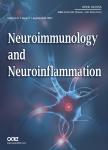Microglial process convergence on axonal segments in health and disease
作者机构:Department of Anatomy and NeurobiologyVirginia Commonwealth UniversityRichmondVA 23298USA
出 版 物:《Neuroimmunology and Neuroinflammation》 (神经免疫与神经炎症(英文版))
年 卷 期:2020年第7卷第1期
页 面:23-39页
学科分类:1002[医学-临床医学] 100210[医学-外科学(含:普外、骨外、泌尿外、胸心外、神外、整形、烧伤、野战外)] 10[医学]
主 题:Microglia multiple sclerosis traumatic brain injury microglia-axonal interactions
摘 要:Microglia dynamically interact with neurons influencing the development, structure, and function of neuronal networks. Recent studies suggest microglia may also influence neuronal activity by physically interacting with axonal domains responsible for action potential initiation and propagation. However, the nature of these microglial process interactions is not well understood. Microglial-axonal contacts are present early in development and persist through adulthood, implicating microglial interactions in the regulation of axonal integrity in both the developing and mature central nervous system. Moreover, changes in microglial-axonal contact have been described in disease states such as multiple sclerosis (MS) and traumatic brain injury (TBI). Depending on the disease state, there are increased associations with specific axonal segments. In MS, there is enhanced contact with the axon initial segment and node of Ranvier, while, in TBI, microglia alter interactions with axons at the site of injury, as well as at the axon initial segment. In this article, we review the interactions of microglial processes with axonal segments, analyzing their associations with various axonal domains and how these interactions may differ between MS and TBI. Furthermore, we discuss potential functional consequences and molecular mechanisms of these interactions and how these may differ among various types of microglial-axonal interactions.



